Evaluating Organizational Cultural Shifts and Their Impacts
VerifiedAdded on 2020/05/11
|10
|3349
|118
AI Summary
The MeatPackers case presents an insightful look into how organizational culture change can significantly impact employee satisfaction and operational efficiency. Initially, the company experienced hurdles primarily due to inadequate communication channels, leading to decreased morale and productivity. The analysis delves into the strategies employed by management to overcome these challenges, emphasizing improved internal communications as a pivotal factor in achieving a seamless transition. By enhancing transparency and fostering open dialogue, MeatPackers successfully navigated through its cultural transformation. This case study not only highlights the importance of effective communication during periods of change but also showcases the positive outcomes associated with employee engagement and job satisfaction post-transition.
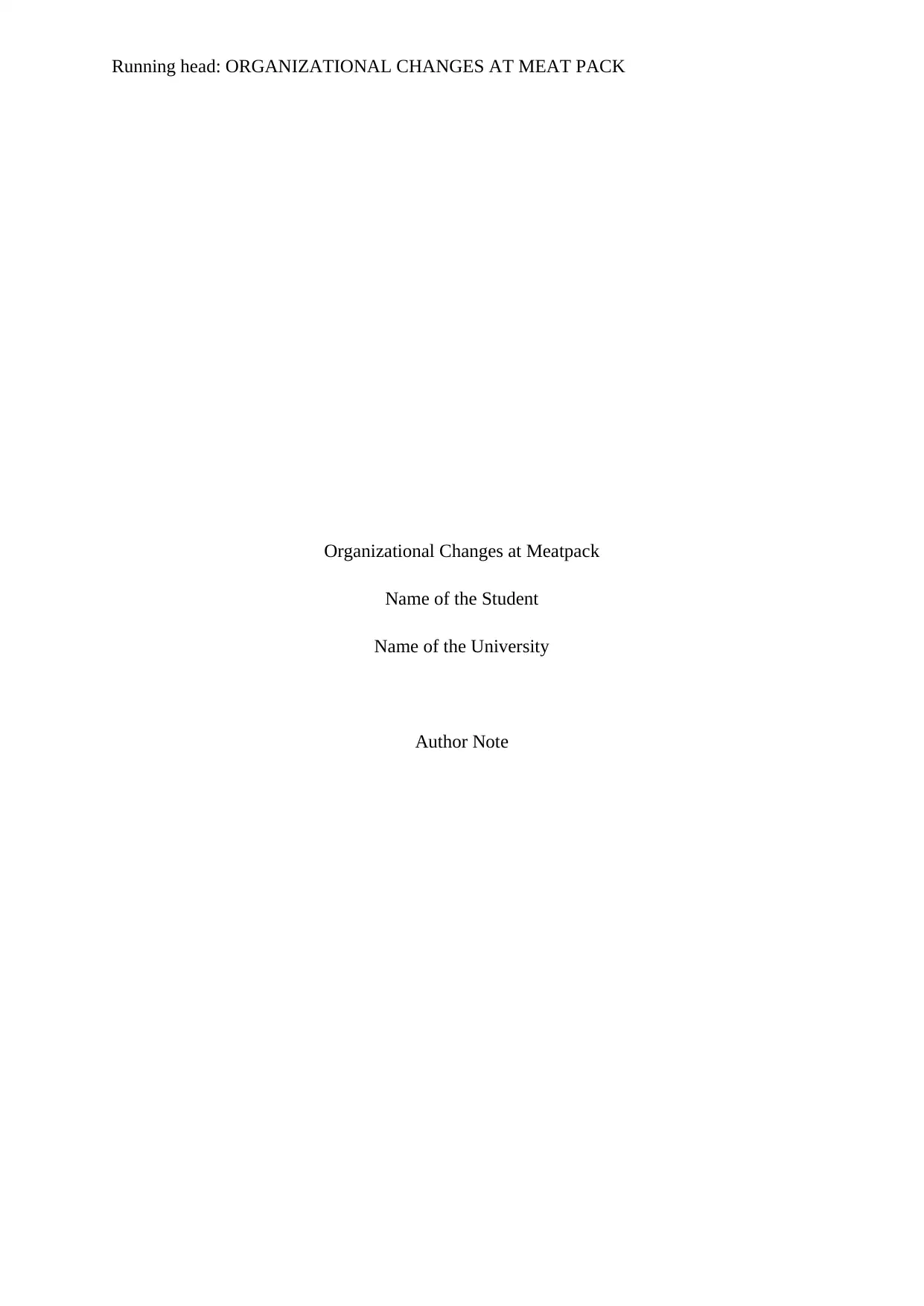
Running head: ORGANIZATIONAL CHANGES AT MEAT PACK
Organizational Changes at Meatpack
Name of the Student
Name of the University
Author Note
Organizational Changes at Meatpack
Name of the Student
Name of the University
Author Note
Paraphrase This Document
Need a fresh take? Get an instant paraphrase of this document with our AI Paraphraser

1ORGANIZATIONAL CHANGES AT MEATPACK
Table of Contents
Answer 1....................................................................................................................................2
Answer 2....................................................................................................................................4
Answer 3....................................................................................................................................6
References..................................................................................................................................8
Table of Contents
Answer 1....................................................................................................................................2
Answer 2....................................................................................................................................4
Answer 3....................................................................................................................................6
References..................................................................................................................................8
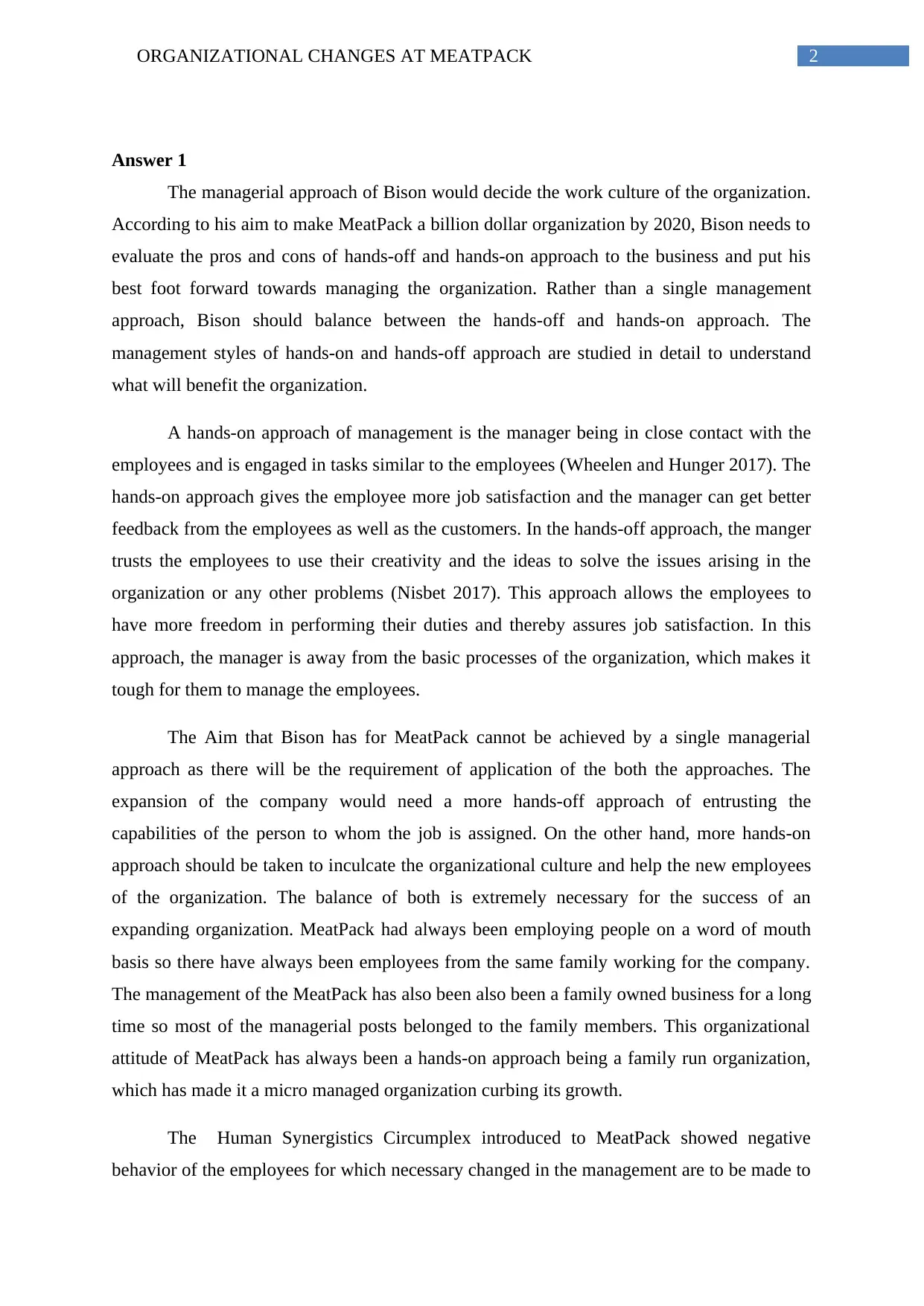
2ORGANIZATIONAL CHANGES AT MEATPACK
Answer 1
The managerial approach of Bison would decide the work culture of the organization.
According to his aim to make MeatPack a billion dollar organization by 2020, Bison needs to
evaluate the pros and cons of hands-off and hands-on approach to the business and put his
best foot forward towards managing the organization. Rather than a single management
approach, Bison should balance between the hands-off and hands-on approach. The
management styles of hands-on and hands-off approach are studied in detail to understand
what will benefit the organization.
A hands-on approach of management is the manager being in close contact with the
employees and is engaged in tasks similar to the employees (Wheelen and Hunger 2017). The
hands-on approach gives the employee more job satisfaction and the manager can get better
feedback from the employees as well as the customers. In the hands-off approach, the manger
trusts the employees to use their creativity and the ideas to solve the issues arising in the
organization or any other problems (Nisbet 2017). This approach allows the employees to
have more freedom in performing their duties and thereby assures job satisfaction. In this
approach, the manager is away from the basic processes of the organization, which makes it
tough for them to manage the employees.
The Aim that Bison has for MeatPack cannot be achieved by a single managerial
approach as there will be the requirement of application of the both the approaches. The
expansion of the company would need a more hands-off approach of entrusting the
capabilities of the person to whom the job is assigned. On the other hand, more hands-on
approach should be taken to inculcate the organizational culture and help the new employees
of the organization. The balance of both is extremely necessary for the success of an
expanding organization. MeatPack had always been employing people on a word of mouth
basis so there have always been employees from the same family working for the company.
The management of the MeatPack has also been also been a family owned business for a long
time so most of the managerial posts belonged to the family members. This organizational
attitude of MeatPack has always been a hands-on approach being a family run organization,
which has made it a micro managed organization curbing its growth.
The Human Synergistics Circumplex introduced to MeatPack showed negative
behavior of the employees for which necessary changed in the management are to be made to
Answer 1
The managerial approach of Bison would decide the work culture of the organization.
According to his aim to make MeatPack a billion dollar organization by 2020, Bison needs to
evaluate the pros and cons of hands-off and hands-on approach to the business and put his
best foot forward towards managing the organization. Rather than a single management
approach, Bison should balance between the hands-off and hands-on approach. The
management styles of hands-on and hands-off approach are studied in detail to understand
what will benefit the organization.
A hands-on approach of management is the manager being in close contact with the
employees and is engaged in tasks similar to the employees (Wheelen and Hunger 2017). The
hands-on approach gives the employee more job satisfaction and the manager can get better
feedback from the employees as well as the customers. In the hands-off approach, the manger
trusts the employees to use their creativity and the ideas to solve the issues arising in the
organization or any other problems (Nisbet 2017). This approach allows the employees to
have more freedom in performing their duties and thereby assures job satisfaction. In this
approach, the manager is away from the basic processes of the organization, which makes it
tough for them to manage the employees.
The Aim that Bison has for MeatPack cannot be achieved by a single managerial
approach as there will be the requirement of application of the both the approaches. The
expansion of the company would need a more hands-off approach of entrusting the
capabilities of the person to whom the job is assigned. On the other hand, more hands-on
approach should be taken to inculcate the organizational culture and help the new employees
of the organization. The balance of both is extremely necessary for the success of an
expanding organization. MeatPack had always been employing people on a word of mouth
basis so there have always been employees from the same family working for the company.
The management of the MeatPack has also been also been a family owned business for a long
time so most of the managerial posts belonged to the family members. This organizational
attitude of MeatPack has always been a hands-on approach being a family run organization,
which has made it a micro managed organization curbing its growth.
The Human Synergistics Circumplex introduced to MeatPack showed negative
behavior of the employees for which necessary changed in the management are to be made to
⊘ This is a preview!⊘
Do you want full access?
Subscribe today to unlock all pages.

Trusted by 1+ million students worldwide
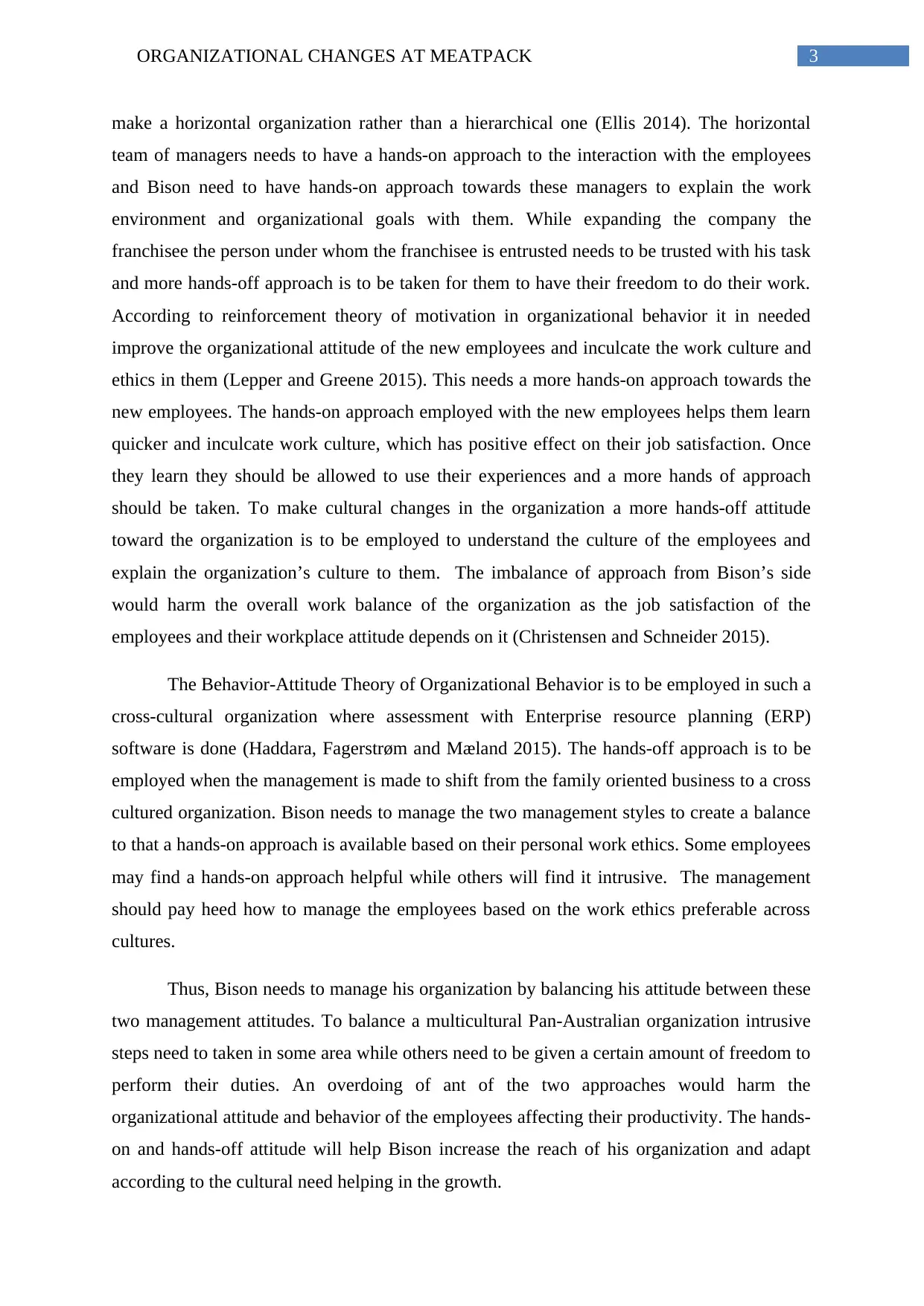
3ORGANIZATIONAL CHANGES AT MEATPACK
make a horizontal organization rather than a hierarchical one (Ellis 2014). The horizontal
team of managers needs to have a hands-on approach to the interaction with the employees
and Bison need to have hands-on approach towards these managers to explain the work
environment and organizational goals with them. While expanding the company the
franchisee the person under whom the franchisee is entrusted needs to be trusted with his task
and more hands-off approach is to be taken for them to have their freedom to do their work.
According to reinforcement theory of motivation in organizational behavior it in needed
improve the organizational attitude of the new employees and inculcate the work culture and
ethics in them (Lepper and Greene 2015). This needs a more hands-on approach towards the
new employees. The hands-on approach employed with the new employees helps them learn
quicker and inculcate work culture, which has positive effect on their job satisfaction. Once
they learn they should be allowed to use their experiences and a more hands of approach
should be taken. To make cultural changes in the organization a more hands-off attitude
toward the organization is to be employed to understand the culture of the employees and
explain the organization’s culture to them. The imbalance of approach from Bison’s side
would harm the overall work balance of the organization as the job satisfaction of the
employees and their workplace attitude depends on it (Christensen and Schneider 2015).
The Behavior-Attitude Theory of Organizational Behavior is to be employed in such a
cross-cultural organization where assessment with Enterprise resource planning (ERP)
software is done (Haddara, Fagerstrøm and Mæland 2015). The hands-off approach is to be
employed when the management is made to shift from the family oriented business to a cross
cultured organization. Bison needs to manage the two management styles to create a balance
to that a hands-on approach is available based on their personal work ethics. Some employees
may find a hands-on approach helpful while others will find it intrusive. The management
should pay heed how to manage the employees based on the work ethics preferable across
cultures.
Thus, Bison needs to manage his organization by balancing his attitude between these
two management attitudes. To balance a multicultural Pan-Australian organization intrusive
steps need to taken in some area while others need to be given a certain amount of freedom to
perform their duties. An overdoing of ant of the two approaches would harm the
organizational attitude and behavior of the employees affecting their productivity. The hands-
on and hands-off attitude will help Bison increase the reach of his organization and adapt
according to the cultural need helping in the growth.
make a horizontal organization rather than a hierarchical one (Ellis 2014). The horizontal
team of managers needs to have a hands-on approach to the interaction with the employees
and Bison need to have hands-on approach towards these managers to explain the work
environment and organizational goals with them. While expanding the company the
franchisee the person under whom the franchisee is entrusted needs to be trusted with his task
and more hands-off approach is to be taken for them to have their freedom to do their work.
According to reinforcement theory of motivation in organizational behavior it in needed
improve the organizational attitude of the new employees and inculcate the work culture and
ethics in them (Lepper and Greene 2015). This needs a more hands-on approach towards the
new employees. The hands-on approach employed with the new employees helps them learn
quicker and inculcate work culture, which has positive effect on their job satisfaction. Once
they learn they should be allowed to use their experiences and a more hands of approach
should be taken. To make cultural changes in the organization a more hands-off attitude
toward the organization is to be employed to understand the culture of the employees and
explain the organization’s culture to them. The imbalance of approach from Bison’s side
would harm the overall work balance of the organization as the job satisfaction of the
employees and their workplace attitude depends on it (Christensen and Schneider 2015).
The Behavior-Attitude Theory of Organizational Behavior is to be employed in such a
cross-cultural organization where assessment with Enterprise resource planning (ERP)
software is done (Haddara, Fagerstrøm and Mæland 2015). The hands-off approach is to be
employed when the management is made to shift from the family oriented business to a cross
cultured organization. Bison needs to manage the two management styles to create a balance
to that a hands-on approach is available based on their personal work ethics. Some employees
may find a hands-on approach helpful while others will find it intrusive. The management
should pay heed how to manage the employees based on the work ethics preferable across
cultures.
Thus, Bison needs to manage his organization by balancing his attitude between these
two management attitudes. To balance a multicultural Pan-Australian organization intrusive
steps need to taken in some area while others need to be given a certain amount of freedom to
perform their duties. An overdoing of ant of the two approaches would harm the
organizational attitude and behavior of the employees affecting their productivity. The hands-
on and hands-off attitude will help Bison increase the reach of his organization and adapt
according to the cultural need helping in the growth.
Paraphrase This Document
Need a fresh take? Get an instant paraphrase of this document with our AI Paraphraser
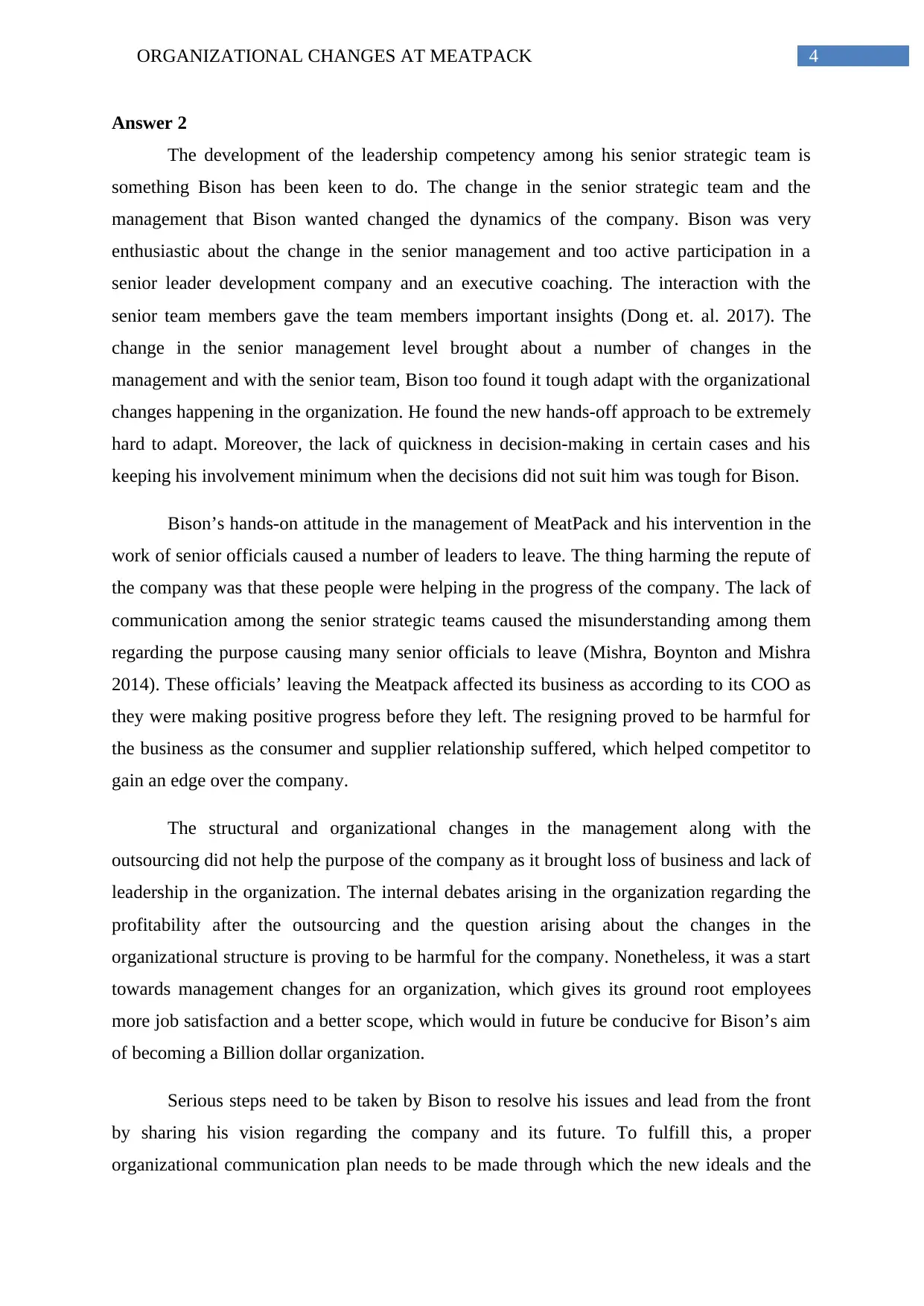
4ORGANIZATIONAL CHANGES AT MEATPACK
Answer 2
The development of the leadership competency among his senior strategic team is
something Bison has been keen to do. The change in the senior strategic team and the
management that Bison wanted changed the dynamics of the company. Bison was very
enthusiastic about the change in the senior management and too active participation in a
senior leader development company and an executive coaching. The interaction with the
senior team members gave the team members important insights (Dong et. al. 2017). The
change in the senior management level brought about a number of changes in the
management and with the senior team, Bison too found it tough adapt with the organizational
changes happening in the organization. He found the new hands-off approach to be extremely
hard to adapt. Moreover, the lack of quickness in decision-making in certain cases and his
keeping his involvement minimum when the decisions did not suit him was tough for Bison.
Bison’s hands-on attitude in the management of MeatPack and his intervention in the
work of senior officials caused a number of leaders to leave. The thing harming the repute of
the company was that these people were helping in the progress of the company. The lack of
communication among the senior strategic teams caused the misunderstanding among them
regarding the purpose causing many senior officials to leave (Mishra, Boynton and Mishra
2014). These officials’ leaving the Meatpack affected its business as according to its COO as
they were making positive progress before they left. The resigning proved to be harmful for
the business as the consumer and supplier relationship suffered, which helped competitor to
gain an edge over the company.
The structural and organizational changes in the management along with the
outsourcing did not help the purpose of the company as it brought loss of business and lack of
leadership in the organization. The internal debates arising in the organization regarding the
profitability after the outsourcing and the question arising about the changes in the
organizational structure is proving to be harmful for the company. Nonetheless, it was a start
towards management changes for an organization, which gives its ground root employees
more job satisfaction and a better scope, which would in future be conducive for Bison’s aim
of becoming a Billion dollar organization.
Serious steps need to be taken by Bison to resolve his issues and lead from the front
by sharing his vision regarding the company and its future. To fulfill this, a proper
organizational communication plan needs to be made through which the new ideals and the
Answer 2
The development of the leadership competency among his senior strategic team is
something Bison has been keen to do. The change in the senior strategic team and the
management that Bison wanted changed the dynamics of the company. Bison was very
enthusiastic about the change in the senior management and too active participation in a
senior leader development company and an executive coaching. The interaction with the
senior team members gave the team members important insights (Dong et. al. 2017). The
change in the senior management level brought about a number of changes in the
management and with the senior team, Bison too found it tough adapt with the organizational
changes happening in the organization. He found the new hands-off approach to be extremely
hard to adapt. Moreover, the lack of quickness in decision-making in certain cases and his
keeping his involvement minimum when the decisions did not suit him was tough for Bison.
Bison’s hands-on attitude in the management of MeatPack and his intervention in the
work of senior officials caused a number of leaders to leave. The thing harming the repute of
the company was that these people were helping in the progress of the company. The lack of
communication among the senior strategic teams caused the misunderstanding among them
regarding the purpose causing many senior officials to leave (Mishra, Boynton and Mishra
2014). These officials’ leaving the Meatpack affected its business as according to its COO as
they were making positive progress before they left. The resigning proved to be harmful for
the business as the consumer and supplier relationship suffered, which helped competitor to
gain an edge over the company.
The structural and organizational changes in the management along with the
outsourcing did not help the purpose of the company as it brought loss of business and lack of
leadership in the organization. The internal debates arising in the organization regarding the
profitability after the outsourcing and the question arising about the changes in the
organizational structure is proving to be harmful for the company. Nonetheless, it was a start
towards management changes for an organization, which gives its ground root employees
more job satisfaction and a better scope, which would in future be conducive for Bison’s aim
of becoming a Billion dollar organization.
Serious steps need to be taken by Bison to resolve his issues and lead from the front
by sharing his vision regarding the company and its future. To fulfill this, a proper
organizational communication plan needs to be made through which the new ideals and the
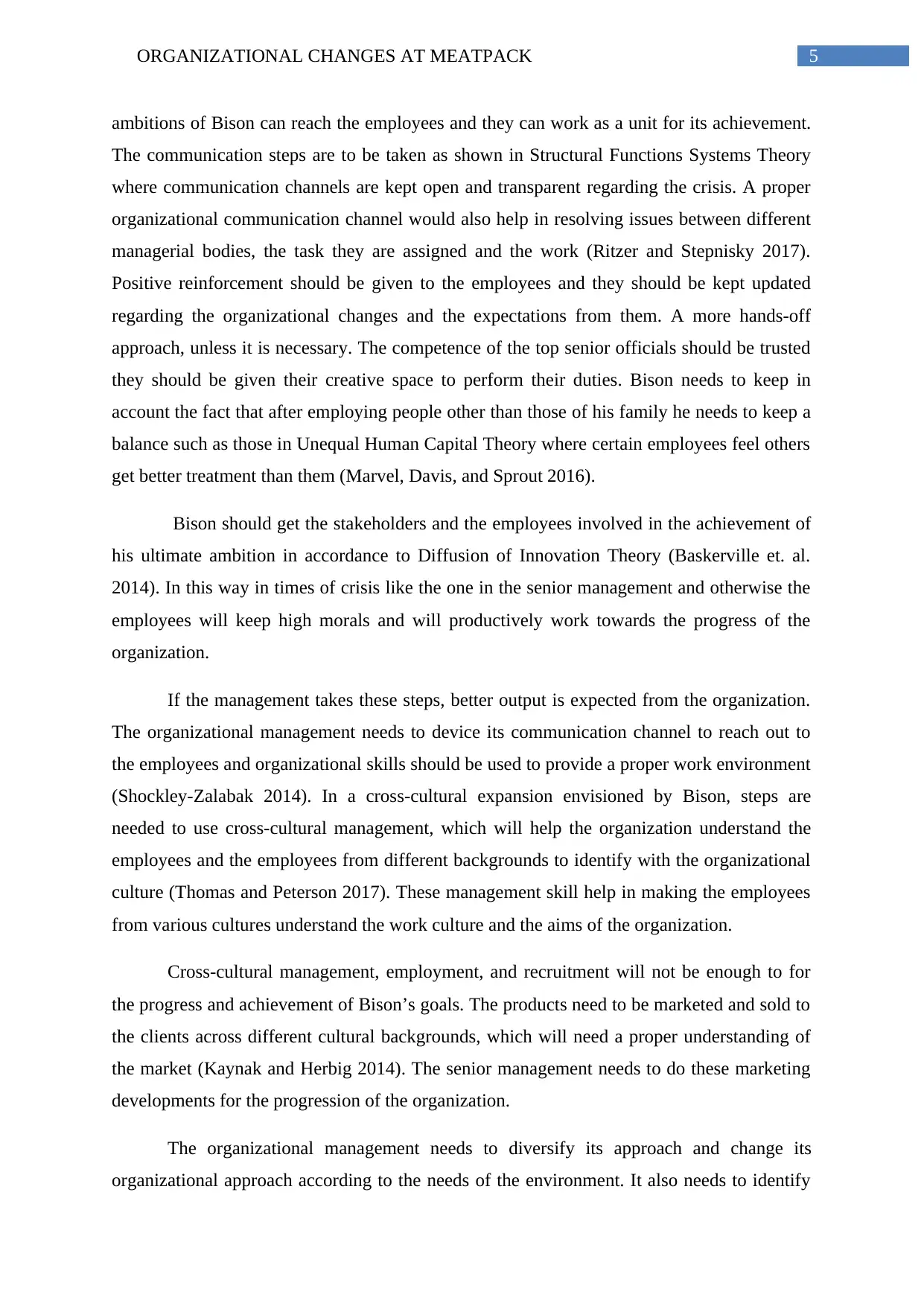
5ORGANIZATIONAL CHANGES AT MEATPACK
ambitions of Bison can reach the employees and they can work as a unit for its achievement.
The communication steps are to be taken as shown in Structural Functions Systems Theory
where communication channels are kept open and transparent regarding the crisis. A proper
organizational communication channel would also help in resolving issues between different
managerial bodies, the task they are assigned and the work (Ritzer and Stepnisky 2017).
Positive reinforcement should be given to the employees and they should be kept updated
regarding the organizational changes and the expectations from them. A more hands-off
approach, unless it is necessary. The competence of the top senior officials should be trusted
they should be given their creative space to perform their duties. Bison needs to keep in
account the fact that after employing people other than those of his family he needs to keep a
balance such as those in Unequal Human Capital Theory where certain employees feel others
get better treatment than them (Marvel, Davis, and Sprout 2016).
Bison should get the stakeholders and the employees involved in the achievement of
his ultimate ambition in accordance to Diffusion of Innovation Theory (Baskerville et. al.
2014). In this way in times of crisis like the one in the senior management and otherwise the
employees will keep high morals and will productively work towards the progress of the
organization.
If the management takes these steps, better output is expected from the organization.
The organizational management needs to device its communication channel to reach out to
the employees and organizational skills should be used to provide a proper work environment
(Shockley-Zalabak 2014). In a cross-cultural expansion envisioned by Bison, steps are
needed to use cross-cultural management, which will help the organization understand the
employees and the employees from different backgrounds to identify with the organizational
culture (Thomas and Peterson 2017). These management skill help in making the employees
from various cultures understand the work culture and the aims of the organization.
Cross-cultural management, employment, and recruitment will not be enough to for
the progress and achievement of Bison’s goals. The products need to be marketed and sold to
the clients across different cultural backgrounds, which will need a proper understanding of
the market (Kaynak and Herbig 2014). The senior management needs to do these marketing
developments for the progression of the organization.
The organizational management needs to diversify its approach and change its
organizational approach according to the needs of the environment. It also needs to identify
ambitions of Bison can reach the employees and they can work as a unit for its achievement.
The communication steps are to be taken as shown in Structural Functions Systems Theory
where communication channels are kept open and transparent regarding the crisis. A proper
organizational communication channel would also help in resolving issues between different
managerial bodies, the task they are assigned and the work (Ritzer and Stepnisky 2017).
Positive reinforcement should be given to the employees and they should be kept updated
regarding the organizational changes and the expectations from them. A more hands-off
approach, unless it is necessary. The competence of the top senior officials should be trusted
they should be given their creative space to perform their duties. Bison needs to keep in
account the fact that after employing people other than those of his family he needs to keep a
balance such as those in Unequal Human Capital Theory where certain employees feel others
get better treatment than them (Marvel, Davis, and Sprout 2016).
Bison should get the stakeholders and the employees involved in the achievement of
his ultimate ambition in accordance to Diffusion of Innovation Theory (Baskerville et. al.
2014). In this way in times of crisis like the one in the senior management and otherwise the
employees will keep high morals and will productively work towards the progress of the
organization.
If the management takes these steps, better output is expected from the organization.
The organizational management needs to device its communication channel to reach out to
the employees and organizational skills should be used to provide a proper work environment
(Shockley-Zalabak 2014). In a cross-cultural expansion envisioned by Bison, steps are
needed to use cross-cultural management, which will help the organization understand the
employees and the employees from different backgrounds to identify with the organizational
culture (Thomas and Peterson 2017). These management skill help in making the employees
from various cultures understand the work culture and the aims of the organization.
Cross-cultural management, employment, and recruitment will not be enough to for
the progress and achievement of Bison’s goals. The products need to be marketed and sold to
the clients across different cultural backgrounds, which will need a proper understanding of
the market (Kaynak and Herbig 2014). The senior management needs to do these marketing
developments for the progression of the organization.
The organizational management needs to diversify its approach and change its
organizational approach according to the needs of the environment. It also needs to identify
⊘ This is a preview!⊘
Do you want full access?
Subscribe today to unlock all pages.

Trusted by 1+ million students worldwide
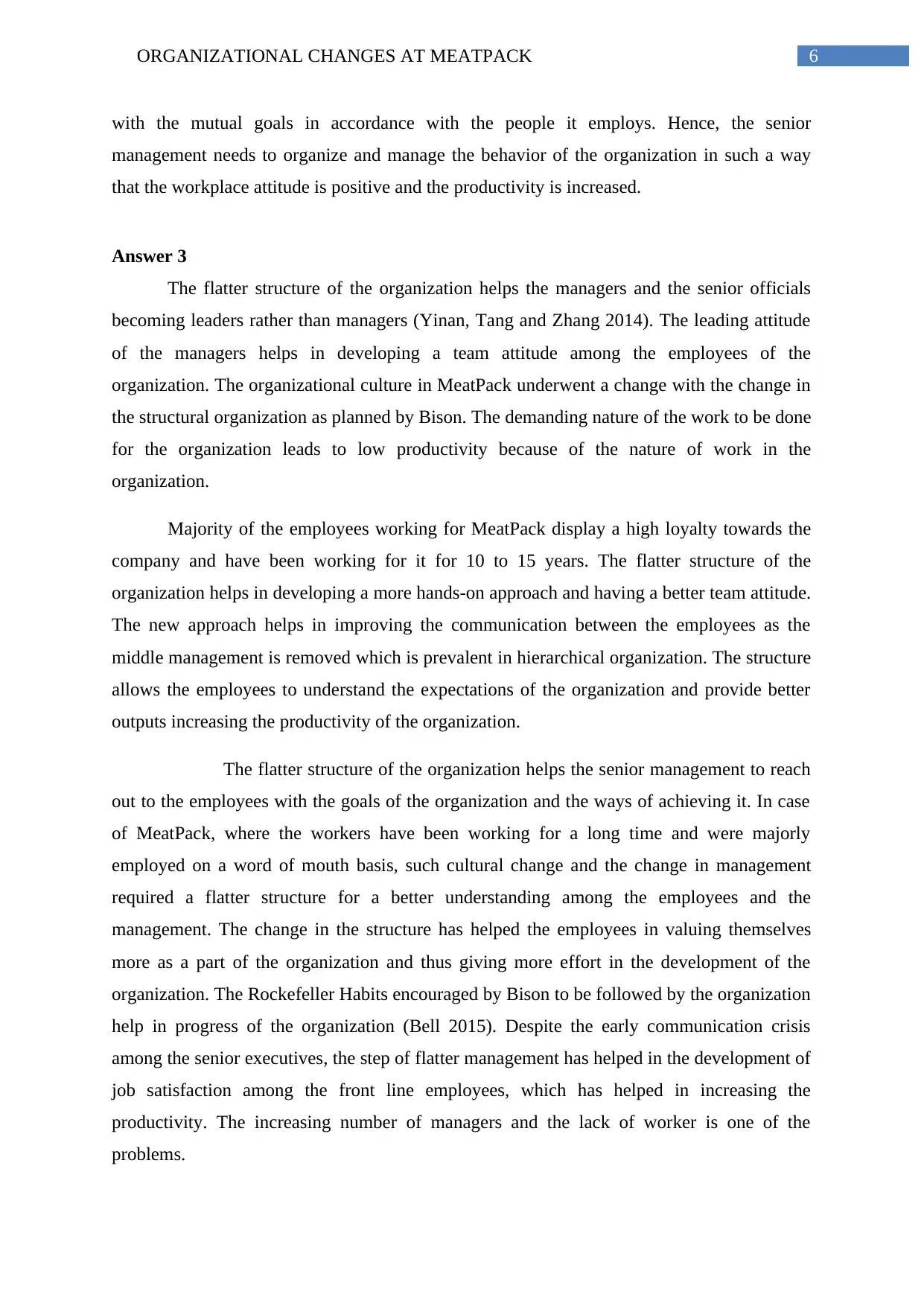
6ORGANIZATIONAL CHANGES AT MEATPACK
with the mutual goals in accordance with the people it employs. Hence, the senior
management needs to organize and manage the behavior of the organization in such a way
that the workplace attitude is positive and the productivity is increased.
Answer 3
The flatter structure of the organization helps the managers and the senior officials
becoming leaders rather than managers (Yinan, Tang and Zhang 2014). The leading attitude
of the managers helps in developing a team attitude among the employees of the
organization. The organizational culture in MeatPack underwent a change with the change in
the structural organization as planned by Bison. The demanding nature of the work to be done
for the organization leads to low productivity because of the nature of work in the
organization.
Majority of the employees working for MeatPack display a high loyalty towards the
company and have been working for it for 10 to 15 years. The flatter structure of the
organization helps in developing a more hands-on approach and having a better team attitude.
The new approach helps in improving the communication between the employees as the
middle management is removed which is prevalent in hierarchical organization. The structure
allows the employees to understand the expectations of the organization and provide better
outputs increasing the productivity of the organization.
The flatter structure of the organization helps the senior management to reach
out to the employees with the goals of the organization and the ways of achieving it. In case
of MeatPack, where the workers have been working for a long time and were majorly
employed on a word of mouth basis, such cultural change and the change in management
required a flatter structure for a better understanding among the employees and the
management. The change in the structure has helped the employees in valuing themselves
more as a part of the organization and thus giving more effort in the development of the
organization. The Rockefeller Habits encouraged by Bison to be followed by the organization
help in progress of the organization (Bell 2015). Despite the early communication crisis
among the senior executives, the step of flatter management has helped in the development of
job satisfaction among the front line employees, which has helped in increasing the
productivity. The increasing number of managers and the lack of worker is one of the
problems.
with the mutual goals in accordance with the people it employs. Hence, the senior
management needs to organize and manage the behavior of the organization in such a way
that the workplace attitude is positive and the productivity is increased.
Answer 3
The flatter structure of the organization helps the managers and the senior officials
becoming leaders rather than managers (Yinan, Tang and Zhang 2014). The leading attitude
of the managers helps in developing a team attitude among the employees of the
organization. The organizational culture in MeatPack underwent a change with the change in
the structural organization as planned by Bison. The demanding nature of the work to be done
for the organization leads to low productivity because of the nature of work in the
organization.
Majority of the employees working for MeatPack display a high loyalty towards the
company and have been working for it for 10 to 15 years. The flatter structure of the
organization helps in developing a more hands-on approach and having a better team attitude.
The new approach helps in improving the communication between the employees as the
middle management is removed which is prevalent in hierarchical organization. The structure
allows the employees to understand the expectations of the organization and provide better
outputs increasing the productivity of the organization.
The flatter structure of the organization helps the senior management to reach
out to the employees with the goals of the organization and the ways of achieving it. In case
of MeatPack, where the workers have been working for a long time and were majorly
employed on a word of mouth basis, such cultural change and the change in management
required a flatter structure for a better understanding among the employees and the
management. The change in the structure has helped the employees in valuing themselves
more as a part of the organization and thus giving more effort in the development of the
organization. The Rockefeller Habits encouraged by Bison to be followed by the organization
help in progress of the organization (Bell 2015). Despite the early communication crisis
among the senior executives, the step of flatter management has helped in the development of
job satisfaction among the front line employees, which has helped in increasing the
productivity. The increasing number of managers and the lack of worker is one of the
problems.
Paraphrase This Document
Need a fresh take? Get an instant paraphrase of this document with our AI Paraphraser
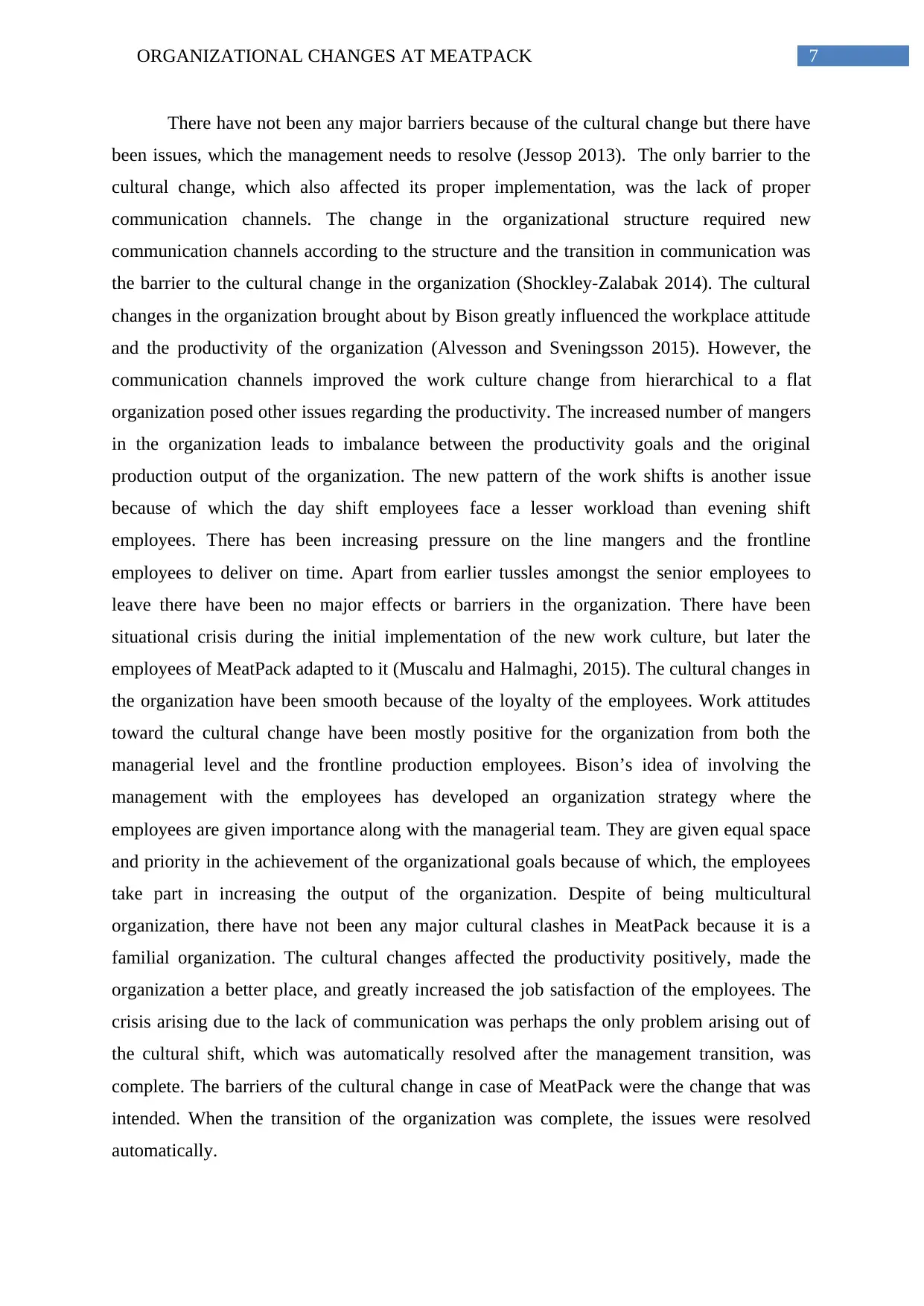
7ORGANIZATIONAL CHANGES AT MEATPACK
There have not been any major barriers because of the cultural change but there have
been issues, which the management needs to resolve (Jessop 2013). The only barrier to the
cultural change, which also affected its proper implementation, was the lack of proper
communication channels. The change in the organizational structure required new
communication channels according to the structure and the transition in communication was
the barrier to the cultural change in the organization (Shockley-Zalabak 2014). The cultural
changes in the organization brought about by Bison greatly influenced the workplace attitude
and the productivity of the organization (Alvesson and Sveningsson 2015). However, the
communication channels improved the work culture change from hierarchical to a flat
organization posed other issues regarding the productivity. The increased number of mangers
in the organization leads to imbalance between the productivity goals and the original
production output of the organization. The new pattern of the work shifts is another issue
because of which the day shift employees face a lesser workload than evening shift
employees. There has been increasing pressure on the line mangers and the frontline
employees to deliver on time. Apart from earlier tussles amongst the senior employees to
leave there have been no major effects or barriers in the organization. There have been
situational crisis during the initial implementation of the new work culture, but later the
employees of MeatPack adapted to it (Muscalu and Halmaghi, 2015). The cultural changes in
the organization have been smooth because of the loyalty of the employees. Work attitudes
toward the cultural change have been mostly positive for the organization from both the
managerial level and the frontline production employees. Bison’s idea of involving the
management with the employees has developed an organization strategy where the
employees are given importance along with the managerial team. They are given equal space
and priority in the achievement of the organizational goals because of which, the employees
take part in increasing the output of the organization. Despite of being multicultural
organization, there have not been any major cultural clashes in MeatPack because it is a
familial organization. The cultural changes affected the productivity positively, made the
organization a better place, and greatly increased the job satisfaction of the employees. The
crisis arising due to the lack of communication was perhaps the only problem arising out of
the cultural shift, which was automatically resolved after the management transition, was
complete. The barriers of the cultural change in case of MeatPack were the change that was
intended. When the transition of the organization was complete, the issues were resolved
automatically.
There have not been any major barriers because of the cultural change but there have
been issues, which the management needs to resolve (Jessop 2013). The only barrier to the
cultural change, which also affected its proper implementation, was the lack of proper
communication channels. The change in the organizational structure required new
communication channels according to the structure and the transition in communication was
the barrier to the cultural change in the organization (Shockley-Zalabak 2014). The cultural
changes in the organization brought about by Bison greatly influenced the workplace attitude
and the productivity of the organization (Alvesson and Sveningsson 2015). However, the
communication channels improved the work culture change from hierarchical to a flat
organization posed other issues regarding the productivity. The increased number of mangers
in the organization leads to imbalance between the productivity goals and the original
production output of the organization. The new pattern of the work shifts is another issue
because of which the day shift employees face a lesser workload than evening shift
employees. There has been increasing pressure on the line mangers and the frontline
employees to deliver on time. Apart from earlier tussles amongst the senior employees to
leave there have been no major effects or barriers in the organization. There have been
situational crisis during the initial implementation of the new work culture, but later the
employees of MeatPack adapted to it (Muscalu and Halmaghi, 2015). The cultural changes in
the organization have been smooth because of the loyalty of the employees. Work attitudes
toward the cultural change have been mostly positive for the organization from both the
managerial level and the frontline production employees. Bison’s idea of involving the
management with the employees has developed an organization strategy where the
employees are given importance along with the managerial team. They are given equal space
and priority in the achievement of the organizational goals because of which, the employees
take part in increasing the output of the organization. Despite of being multicultural
organization, there have not been any major cultural clashes in MeatPack because it is a
familial organization. The cultural changes affected the productivity positively, made the
organization a better place, and greatly increased the job satisfaction of the employees. The
crisis arising due to the lack of communication was perhaps the only problem arising out of
the cultural shift, which was automatically resolved after the management transition, was
complete. The barriers of the cultural change in case of MeatPack were the change that was
intended. When the transition of the organization was complete, the issues were resolved
automatically.
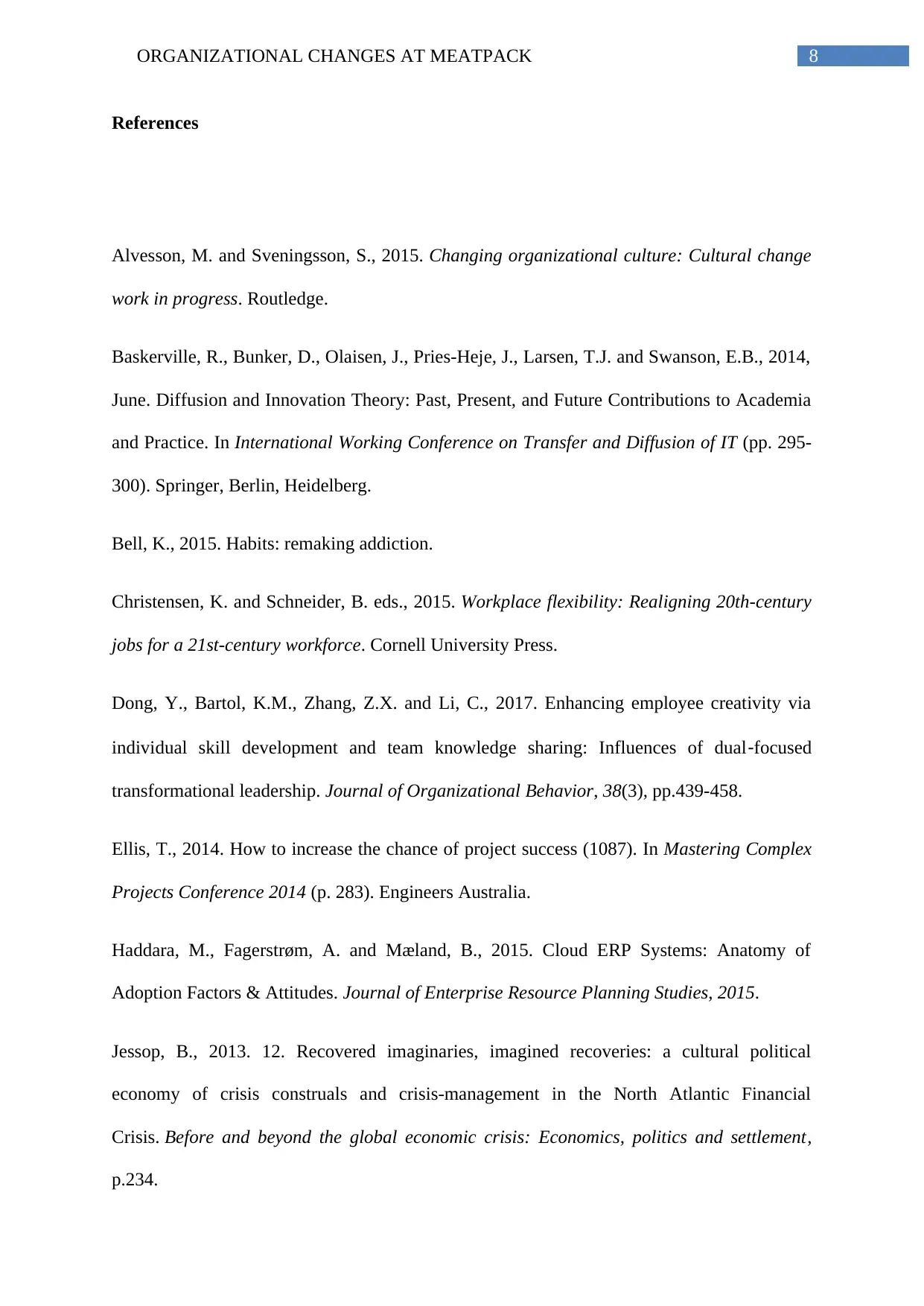
8ORGANIZATIONAL CHANGES AT MEATPACK
References
Alvesson, M. and Sveningsson, S., 2015. Changing organizational culture: Cultural change
work in progress. Routledge.
Baskerville, R., Bunker, D., Olaisen, J., Pries-Heje, J., Larsen, T.J. and Swanson, E.B., 2014,
June. Diffusion and Innovation Theory: Past, Present, and Future Contributions to Academia
and Practice. In International Working Conference on Transfer and Diffusion of IT (pp. 295-
300). Springer, Berlin, Heidelberg.
Bell, K., 2015. Habits: remaking addiction.
Christensen, K. and Schneider, B. eds., 2015. Workplace flexibility: Realigning 20th-century
jobs for a 21st-century workforce. Cornell University Press.
Dong, Y., Bartol, K.M., Zhang, Z.X. and Li, C., 2017. Enhancing employee creativity via
individual skill development and team knowledge sharing: Influences of dual‐focused
transformational leadership. Journal of Organizational Behavior, 38(3), pp.439-458.
Ellis, T., 2014. How to increase the chance of project success (1087). In Mastering Complex
Projects Conference 2014 (p. 283). Engineers Australia.
Haddara, M., Fagerstrøm, A. and Mæland, B., 2015. Cloud ERP Systems: Anatomy of
Adoption Factors & Attitudes. Journal of Enterprise Resource Planning Studies, 2015.
Jessop, B., 2013. 12. Recovered imaginaries, imagined recoveries: a cultural political
economy of crisis construals and crisis-management in the North Atlantic Financial
Crisis. Before and beyond the global economic crisis: Economics, politics and settlement,
p.234.
References
Alvesson, M. and Sveningsson, S., 2015. Changing organizational culture: Cultural change
work in progress. Routledge.
Baskerville, R., Bunker, D., Olaisen, J., Pries-Heje, J., Larsen, T.J. and Swanson, E.B., 2014,
June. Diffusion and Innovation Theory: Past, Present, and Future Contributions to Academia
and Practice. In International Working Conference on Transfer and Diffusion of IT (pp. 295-
300). Springer, Berlin, Heidelberg.
Bell, K., 2015. Habits: remaking addiction.
Christensen, K. and Schneider, B. eds., 2015. Workplace flexibility: Realigning 20th-century
jobs for a 21st-century workforce. Cornell University Press.
Dong, Y., Bartol, K.M., Zhang, Z.X. and Li, C., 2017. Enhancing employee creativity via
individual skill development and team knowledge sharing: Influences of dual‐focused
transformational leadership. Journal of Organizational Behavior, 38(3), pp.439-458.
Ellis, T., 2014. How to increase the chance of project success (1087). In Mastering Complex
Projects Conference 2014 (p. 283). Engineers Australia.
Haddara, M., Fagerstrøm, A. and Mæland, B., 2015. Cloud ERP Systems: Anatomy of
Adoption Factors & Attitudes. Journal of Enterprise Resource Planning Studies, 2015.
Jessop, B., 2013. 12. Recovered imaginaries, imagined recoveries: a cultural political
economy of crisis construals and crisis-management in the North Atlantic Financial
Crisis. Before and beyond the global economic crisis: Economics, politics and settlement,
p.234.
⊘ This is a preview!⊘
Do you want full access?
Subscribe today to unlock all pages.

Trusted by 1+ million students worldwide
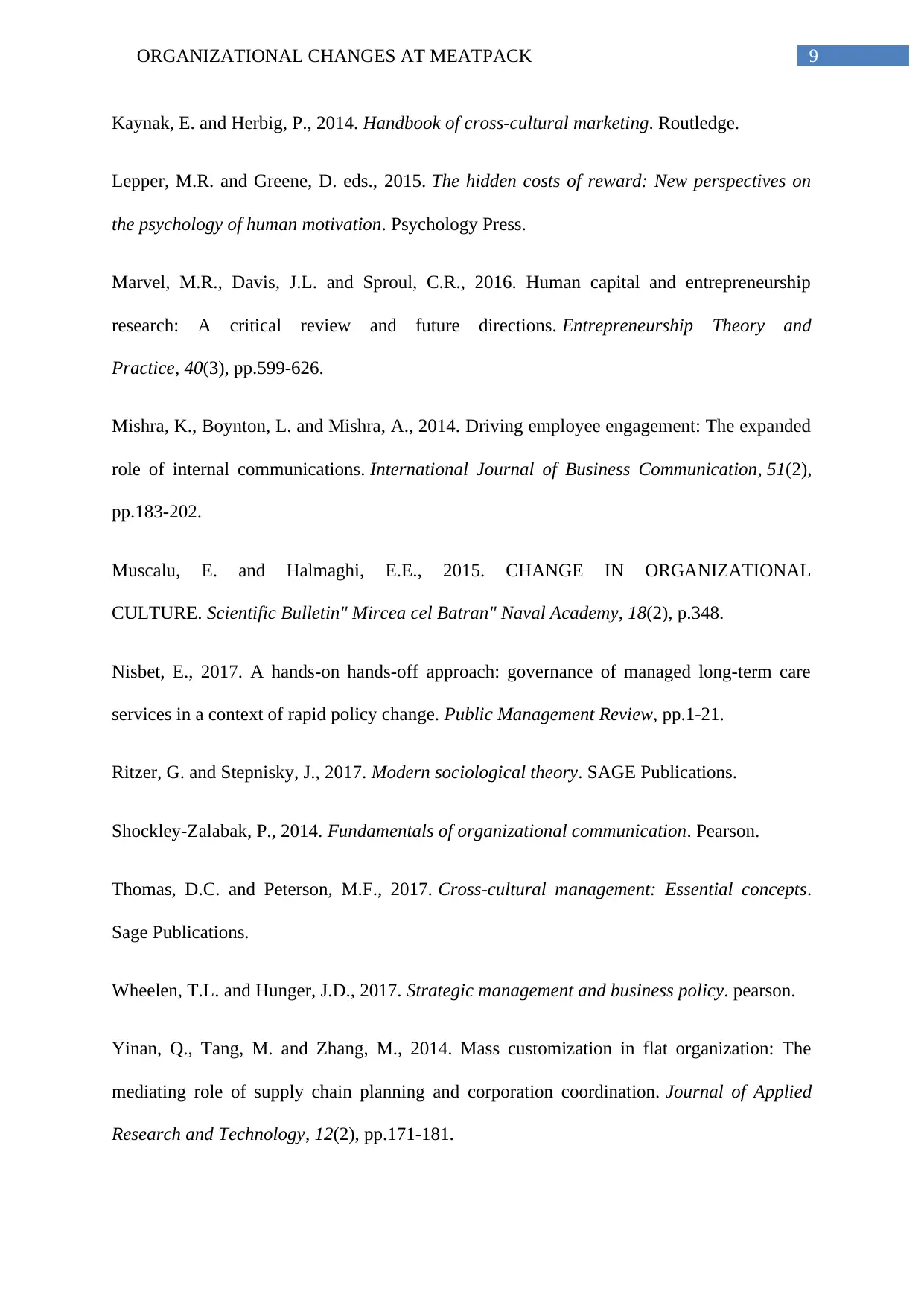
9ORGANIZATIONAL CHANGES AT MEATPACK
Kaynak, E. and Herbig, P., 2014. Handbook of cross-cultural marketing. Routledge.
Lepper, M.R. and Greene, D. eds., 2015. The hidden costs of reward: New perspectives on
the psychology of human motivation. Psychology Press.
Marvel, M.R., Davis, J.L. and Sproul, C.R., 2016. Human capital and entrepreneurship
research: A critical review and future directions. Entrepreneurship Theory and
Practice, 40(3), pp.599-626.
Mishra, K., Boynton, L. and Mishra, A., 2014. Driving employee engagement: The expanded
role of internal communications. International Journal of Business Communication, 51(2),
pp.183-202.
Muscalu, E. and Halmaghi, E.E., 2015. CHANGE IN ORGANIZATIONAL
CULTURE. Scientific Bulletin" Mircea cel Batran" Naval Academy, 18(2), p.348.
Nisbet, E., 2017. A hands-on hands-off approach: governance of managed long-term care
services in a context of rapid policy change. Public Management Review, pp.1-21.
Ritzer, G. and Stepnisky, J., 2017. Modern sociological theory. SAGE Publications.
Shockley-Zalabak, P., 2014. Fundamentals of organizational communication. Pearson.
Thomas, D.C. and Peterson, M.F., 2017. Cross-cultural management: Essential concepts.
Sage Publications.
Wheelen, T.L. and Hunger, J.D., 2017. Strategic management and business policy. pearson.
Yinan, Q., Tang, M. and Zhang, M., 2014. Mass customization in flat organization: The
mediating role of supply chain planning and corporation coordination. Journal of Applied
Research and Technology, 12(2), pp.171-181.
Kaynak, E. and Herbig, P., 2014. Handbook of cross-cultural marketing. Routledge.
Lepper, M.R. and Greene, D. eds., 2015. The hidden costs of reward: New perspectives on
the psychology of human motivation. Psychology Press.
Marvel, M.R., Davis, J.L. and Sproul, C.R., 2016. Human capital and entrepreneurship
research: A critical review and future directions. Entrepreneurship Theory and
Practice, 40(3), pp.599-626.
Mishra, K., Boynton, L. and Mishra, A., 2014. Driving employee engagement: The expanded
role of internal communications. International Journal of Business Communication, 51(2),
pp.183-202.
Muscalu, E. and Halmaghi, E.E., 2015. CHANGE IN ORGANIZATIONAL
CULTURE. Scientific Bulletin" Mircea cel Batran" Naval Academy, 18(2), p.348.
Nisbet, E., 2017. A hands-on hands-off approach: governance of managed long-term care
services in a context of rapid policy change. Public Management Review, pp.1-21.
Ritzer, G. and Stepnisky, J., 2017. Modern sociological theory. SAGE Publications.
Shockley-Zalabak, P., 2014. Fundamentals of organizational communication. Pearson.
Thomas, D.C. and Peterson, M.F., 2017. Cross-cultural management: Essential concepts.
Sage Publications.
Wheelen, T.L. and Hunger, J.D., 2017. Strategic management and business policy. pearson.
Yinan, Q., Tang, M. and Zhang, M., 2014. Mass customization in flat organization: The
mediating role of supply chain planning and corporation coordination. Journal of Applied
Research and Technology, 12(2), pp.171-181.
1 out of 10
Related Documents
Your All-in-One AI-Powered Toolkit for Academic Success.
+13062052269
info@desklib.com
Available 24*7 on WhatsApp / Email
![[object Object]](/_next/static/media/star-bottom.7253800d.svg)
Unlock your academic potential
Copyright © 2020–2025 A2Z Services. All Rights Reserved. Developed and managed by ZUCOL.




